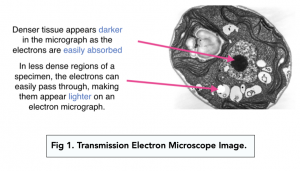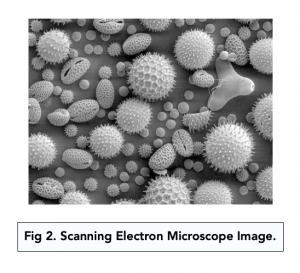Studying Cells: Electron Microscopes (A-level Biology)
Electron Microscopy
- Electron microscopes use electrons to form images. Because electrons are smaller than photons of light, electron microscopes have a much greater resolution than optical microscopes.
- The maximum resolution of an electron microscope is 0.002 micrometers. This means that electron microscopes can be used to produce very detailed images of tiny structures. Images produced by electron microscopes are called electron micrographs.
- The maximum magnification is x500,000. Because the resolution is so good, the useful magnification can be very high.
- Electron micrographs are typically black and white. Electrons cannot be seen by the human eye, so instead the electrons are projected onto a fluorescent screen, where they form a black and white image.
- There are two types of EM. There are two major types of electron microscopy: TEM and SEM (see below).
Transmission Electron Microscope (TEM)
- TEM projects an electron beam through a sample. An electromagnetic beam of electrons is projected onto the sample, and a 2D image is formed.
- Denser tissue appears darker in the micrograph. In denser regions of the specimen, the electrons are easily absorbed, making these regions look darker on an electron micrograph. In less dense regions of a specimen, the electrons can easily pass through, making them appear lighter on an electron micrograph.
- A TEM produces very high-resolution images. TEM can be used to produce very detailed images of cell organelles, which is very useful. For example, you can see the stacked grana inside of chlorophylls.
- Limitation: TEM must be performed in a vacuum. TEM cannot be performed in normal air. Living specimens cannot survive in a vaccuum, so TEM cannot be used to visualise living material.
- Limitation: TEM can only be used for thin tissues. Another limitation of TEM is that it must be performed on very thin specimens, since thick specimens easily absorb the electrons and therefore do not produce good images.

Scanning Electron Microscope (SEM)
- SEM directs an electron beam across a sample. SEM is different from TEM in that it projects electrons across a specimen instead of simply passing electrons through it.
- Electrons are captured by a cathode ray tube. The scanning process releases electrons from the specimen which are captured in a special instrument known as a cathode ray tube. The electrons captured by this cathode ray tube can be used to create an image of a specimen.
- SEM can produce 3D images of a specimen. Because the SEM can scan the surface of a specimen and capture all the textures of the specimen’s surface.
- SEM can be used on thick specimens. Unlike the TEM, the SEM be used to see thick specimens.
- Limitation: SEM has a lower resolution. Compared to TEM, the SEM provides lower resolution images.

Staining in Electron Microscopy
- Stains used for electron microscopy specimens are heavy metals. Unlike stains for light microscopy which are dyes, the stains for electron microscopy are heavy metals. The metal ions cause the electrons in the specimen to scatter, which causes some areas of the specimen to appear darker than others (i.e. generates contrast in the image).
- The most commonly used stains are uranium and lead.
Benefits of Light over Electron Microscopy
Overall, electron microscopy is a very useful tool in biology compared to optical microscopy. However, there are several limitations:
- Light microscopy can be used to visualise living and non-living specimens. Whereas electron microscopy can only work with dead specimens.
- Light microscopy is relatively quick. The preparation process is very easy and does not take too much time to prepare specimens for microscopy. Electron microscopy is very time consuming and laborious, especially during the preparation of the specimen for microscopy.
- Light microscopy is less expensive. Electron microscopy is very expensive. A decent electron microscope can cost upwards of a million pounds, whereas an average light microscope is a few hundred pounds. Additionally, the reagents needed to prepare specimens for electron microscopy are much more expensive than the reagents needed to prepare specimens for light microscopy.
An Electron Microscope is a type of microscope that uses a beam of electrons to produce high-resolution images of biological samples. Unlike light microscopes, which use light to form images, electron microscopes use a beam of electrons to produce images that are much more detailed and have a much higher magnification.
An Electron Microscope works by firing a beam of electrons at a biological sample, which then interacts with the sample and produces an image. The electrons are focused into a beam using magnetic lenses and are then directed towards the sample. The electrons penetrate the sample and interact with the atoms within it, producing an image that can be captured and viewed on a screen.
There are several benefits of using an Electron Microscope, including:
High magnification: Electron Microscopes have a much higher magnification than light microscopes, allowing for the observation of incredibly small structures within cells.
High resolution: The images produced by Electron Microscopes are much more detailed than those produced by light microscopes, providing a clearer picture of the structures within cells.
The ability to observe three-dimensional structures: Electron Microscopes can produce three-dimensional images of biological samples, allowing for the observation of structures that are not visible using light microscopes.
The ability to observe internal structures: Electron Microscopes can observe internal structures within cells, such as organelles, that are not visible using light microscopes.
There are two main types of Electron Microscopes: Transmission Electron Microscopes (TEM) and Scanning Electron Microscopes (SEM). TEMs produce images by passing electrons through a thin section of a biological sample, while SEMs produce images by scanning the surface of a biological sample with a beam of electrons.
There are several limitations of Electron Microscopes, including:
Cost: Electron Microscopes are much more expensive than light microscopes and require specialized training to use.
Preparation of samples: Preparing biological samples for use in Electron Microscopes can be time-consuming and complex, requiring specialized training and equipment.
Sample damage: Electron Microscopes can damage biological samples, making it difficult to study living cells or tissues.
Size and complexity: Electron Microscopes are much larger and more complex than light microscopes and require specialized facilities to use.
The study of Electron Microscopes is important for A-Level Biology students as it provides a fundamental understanding of the techniques and technologies used to study cells and other biological samples. Understanding how Electron Microscopes work and their benefits and limitations can help students to understand the limitations of other techniques, such as light microscopy, and to develop a more comprehensive understanding of cell structure and function.
The use of Electron Microscopes has greatly contributed to scientific research by providing a much more detailed understanding of cell structure and function. Electron Microscopes have allowed scientists to study the structures within cells in much greater detail, leading to a better understanding of cellular processes such as protein synthesis, cellular respiration, and cell division. The use of Electron Microscopes has also helped to advance our understanding of diseases and medical conditions.






Still got a question? Leave a comment
Leave a comment